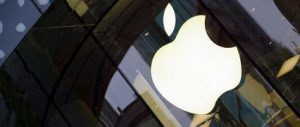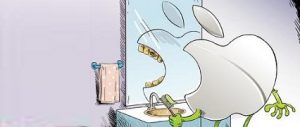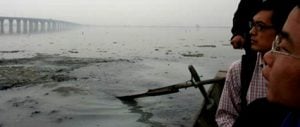Editor’s note: In August, the efforts of a coalition of Chinese environmental NGOs to lobby Apple for less secrecy and better supply-chain management came to global attention, following publication of an investigation into the corporation’s environmental performance and a flurry of worldwide media reports. Two months on, the campaign is making progress – and still getting column inches in the Chinese press. Here we publish an edited translation of an article by newspaper National Business Daily on the latest movements. For the full background to this story, see chinadialogue article “Apple: back under the spotlight”.
In the face of sustained pressure from Chinese green groups, Apple has finally broken its silence on pollution problems in its supply chain, for the first time holding talks with the environmental organisations that, for many months, have been asking the firm to increase transparency – and improve oversight – of its China operations. Ma Jun, director of the Institute for Public and Environmental Affairs (IPE) and the man fronting the campaign, has already had preliminary discussions with Apple chiefs in California, while representatives of the wider NGO coalition may soon visit the United States for formal talks.
On September 26, Ma spoke to Apple executives about technical matters including use of the IPE’s pollution databases (which monitor corporate environmental performance) and supplier audits. He told a National Business Daily reporter: “We’re looking for better ways to communicate and, if possible, Chinese environmental groups will visit the United States in early November for a first round of formal talks with Apple.”
China’s environmental NGOs have been working with their US counterparts to ramp up the pressure on Apple, who they accuse of secrecy and poor supplier management. On September 13, president of the New York-based Natural Resources Defense Council (NRDC) Frances Beinecke wrote to new Apple chief executive Tim Cook, prompting Apple to contact both the IPE and the NRDC to arrange meetings. An NRDC official said: “Apple will soon visit and investigate the manufacturers mentioned in the report.” That report, The Other Side of Apple 2, was published by the IPE and other environmental groups and contained allegations of serious pollution by Apple’s Chinese suppliers.
Apple’s vice president for sustainable development strategy had previously contacted the IPE to say the company planned to check the environmental performance of its suppliers in line with the content of the report and to suggest a first round of communication via a conference call.
In her letter to Cook, Beinecke wrote that her organisation “call[s] upon you to increase Apple’s oversight of the environmental performance of factories in its supply chain. We urge you to make this an immediate priority for your new tenure at Apple.”
In her four-page letter (which has not been released publicly), Beinecke set out four key requests from the NRDC and partner organisation the IPE. First, the organisations ask that Apple check its suppliers against China’s public databases of polluting companies. Second, they want Apple’s supply chain audits to extend beyond tier-one suppliers – the companies that actually assemble Apple products – to cover component manufacturers as well. Third, they say Apple should change its current procurement policy and make environmental pollution a “core violation”. And fourth, they ask that Apple include environmental performance as a key measure in supplier evaluations.
Beinecke said the NRDC would be willing to work with the company to find the best way to improve management of its supply chain and prevent pollution.
In her letter, Beinecke reminded Cook of the large number of problems listed in the IPE report – problems which need urgent attention. Examples include factories “chronically out of compliance” with environmental regulations, with as many as 10 or more violations; factories discharging toxic metals such as copper and nickel at levels that breach international safety standards; factories ignoring the health concerns of local communities; and problems with disposal of hazardous waste.
She stressed that the IPE report and Apple’s own audits had reached the same conclusion. According to “Apple’s Supplier Responsibility 2011 Progress Report”, many suppliers were found to be in severe breach of environmental laws – 80 of 127 factories had not properly stored or handled hazardous chemicals; 41 did not recycle or dispose of hazardous waste properly or as required by law; 37 did not monitor and control air emissions, and more than 10 had wastewater problems; 63 did not have the permits required by government authorities, including approval of their environmental impact assessments.
Apple’s existing supply-chain policies include something called “core violations”. When a supplier is found to have committed one of these, it is ordered to rectify the situation immediately and placed on probation for one year. After that period, it is re-audited to make sure the issue has been resolved. However, environmental breaches are rarely – if ever – counted as “core violations”. In 2010, Apple audited 127 suppliers, but not one of the “core violations” reported was connected to environmental pollution, even though the investigation found major issues with management of hazardous substances, waste-water, air pollution and environmental permits. “Clearly, Apple needs to review and revise its definition of ‘significant violation’ in order to remedy and guard against the types of problems highlighted in the IPE report,” Beinecke said.
The “Apple and the Environment” section of Apple’s website lists the efforts the corporation makes to manage the environmental performance of its suppliers, including reducing greenhouse-gas emissions and removing toxic substances. Apple’s “Supplier Code of Conduct” also lists detailed rules on control of hazardous substances, solid waste, waste-water and air emissions.
But these rules have failed to prevent Apple suppliers from polluting and this, says the NRDC, is because Apple does not take prevention of supplier pollution sufficiently seriously. Many suppliers suspected of breaches receive no significant sanction from Apple. The NRDC also pointed out that Apple does not report any due diligence actions to pro-actively review a potential supplier’s environmental performance before awarding business. Apple has not yet confirmed whether or not it takes such steps.
It would not be difficult for the firm to vet suppliers, according to Ma Jun. “This information can be found on the IPE’s pollution map, or in data from provincial and local governments,” he said. The campaigners believe Apple should check for breaches of environmental law by suppliers and hold back or cancel contracts accordingly.
Other international corporations, including General Electric and Nike, are already working closely with the IPE, and have introduced mandatory checks on environmental performance before suppliers can be given orders.
Beinecke pointed out that a crucial and prominent failing in Apple’s existing policies is that they focus on auditing tier one – final assembly – suppliers. “Although this step in the supply chain is often labour-heavy, it seldom is where the largest environmental footprint in the supply chain lies,” she wrote in her letter to Cook. On the contrary, tier two and tier three suppliers, the companies that manufacture components such as printed circuit boards (PCBs), are where many of the environmental problems have been found.
One supplier, who preferred to remain anonymous, told National Business Daily that the high density PCBs used in iPhones and iPads require a lot of power and water to manufacture, as well as large quantities of chemicals for etching the laminate. The process results in large quantities of air and water pollution, and environmental violations can easily occur.
Ma Jun said: “Publicly available information shows that Apple already works closely with every part of its supply chain, and it would be entirely possible for the firm to control environmental issues at tier-two and tier-three suppliers.” However, Apple’s key performance indicators (KPIs) have no measures relating to environmental responsibility, greatly reducing environmental demands placed on suppliers.
An NRDC spokesperson told National Business Daily: “Although Apple has said it will visit the suppliers mentioned in the report, it has not responded directly to the calls made by the NRDC, nor has it provided proposals or timetables for solving the issues.” But that, in comparison with the company’s earlier silence, is a good start, the spokesperson said.
Apple meanwhile said it has no further information to share at this moment.
This is an edited version of an article first published by National Business Daily, where Xie Xiaoping is a reporter.
Homepage image by Aphrodite





